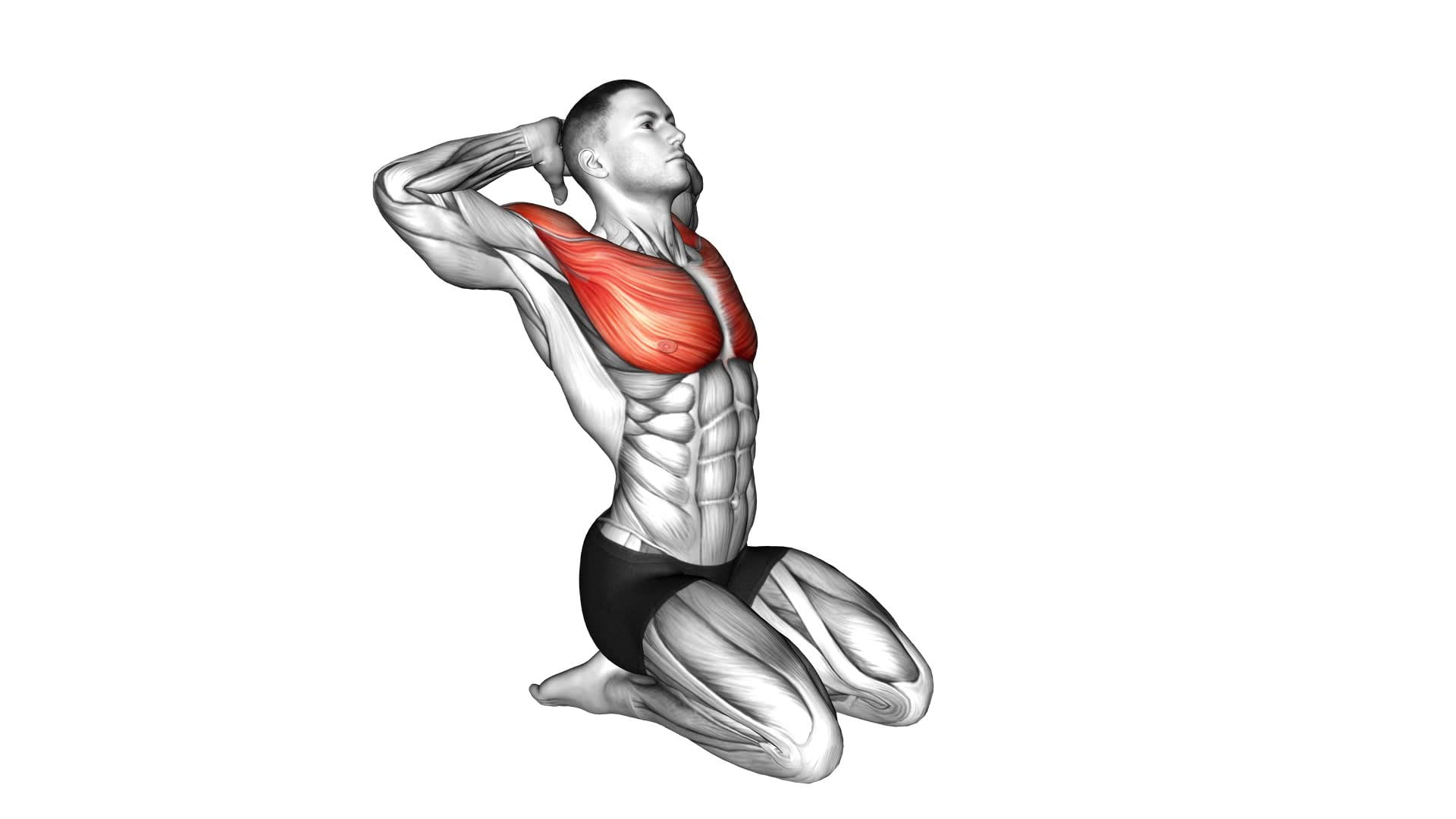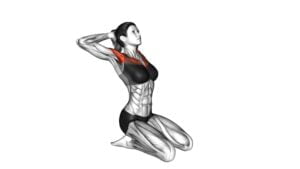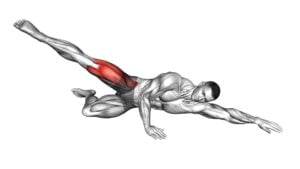Seated Chest Clam (male) – Video Exercise Guide & Tips

Get ready to sculpt your chest with the Seated Chest Clam (male) exercise. This video exercise guide and tips will show you the proper form and technique for maximum results. Avoid common mistakes and learn variations and modifications to challenge yourself.
Watch This Exercise Video
Incorporate this exercise into your workout routine to strengthen your chest muscles effectively. Stay safe and get ready to feel the burn with the Seated Chest Clam (male) exercise.
Key Takeaways
- Seated Chest Clam exercise targets chest, shoulders, and upper back muscles.
- Engaging the core during the exercise enhances stability, strength, and posture.
- Proper arm positioning with bent arms at a 90-degree angle reduces the risk of injury and ensures controlled movement.
- It is important to maintain proper form, avoid common mistakes, and take safety precautions to protect the spine and maximize exercise effectiveness.
Benefits of the Seated Chest Clam (Male) Exercise
You'll experience several benefits from incorporating the Seated Chest Clam (Male) exercise into your workout routine. This exercise specifically targets the muscles in your chest, shoulders, and upper back, helping to improve overall upper body strength and posture.
One of the key benefits of the Seated Chest Clam (Male) exercise is that it promotes proper breathing technique. As you perform the exercise, you'll be required to inhale deeply and exhale forcefully, engaging your core muscles and promoting better oxygen flow throughout your body. This can enhance your overall workout performance and help you achieve better results.
Additionally, the Seated Chest Clam (Male) exercise provides a great alternative to traditional chest exercises such as bench presses or push-ups. By using a seated position and focusing on controlled, isolated movements, you can effectively target and strengthen your chest muscles without putting excessive strain on your joints. This is especially beneficial for individuals with joint issues or those looking to mix up their workout routine.
Incorporating the Seated Chest Clam (Male) exercise into your workout routine can bring about significant benefits, including improved upper body strength, better posture, enhanced breathing technique, and a refreshing alternative to traditional chest exercises. Consider adding this exercise to your routine and start reaping the rewards.
Proper Form and Technique for the Seated Chest Clam (Male) Exercise
To ensure proper form and technique during the Seated Chest Clam (Male) exercise, it's crucial to pay attention to your arm positioning. Keep your elbows at a 90-degree angle and maintain a steady grip on the handles.
Engaging your core throughout the exercise not only enhances stability but also increases the effectiveness of the workout.
Avoid common form mistakes such as rounding your shoulders or arching your back, as these can lead to injury and compromise the targeted muscle engagement.
Arm Positioning Importance
Place your arms in the correct position to ensure proper form and technique for the seated chest clam (male) exercise. Proper arm alignment is crucial for maximizing the benefits of this exercise.
When performing the seated chest clam, your arms should be bent at a 90-degree angle, with your elbows positioned directly beneath your shoulders. This positioning helps to engage the muscles of the chest and upper body effectively. It also ensures that the movement is targeted and controlled, reducing the risk of injury.
Maintaining proper arm alignment throughout the exercise will help you to maintain proper posture and stability, allowing you to focus on contracting and engaging the chest muscles. Remember to keep your arms in this position throughout the entire movement for optimal results.
Core Engagement Benefits
To maximize the benefits of the seated chest clam (male) exercise, it's crucial that you consistently engage your core throughout the movement. Core engagement plays a significant role in maintaining stability and proper form, ensuring that you target the intended muscles effectively. By activating your core, you create a solid foundation for the exercise, allowing you to generate more power and control during the movement.
The seated chest clam exercise primarily targets the chest muscles, but engaging your core also activates the surrounding muscles, such as the abdominals and obliques. This increased muscle activation not only strengthens your core but also enhances overall stability and posture.
Common Form Mistakes
You should always maintain proper form and technique when performing the seated chest clam (male) exercise to avoid common form mistakes.
To ensure core stability, keep your abdominals engaged throughout the movement. Avoid arching your back or slouching forward, as this can put strain on your lower back.
It's important to maintain proper shoulder alignment by keeping your shoulders down and back, away from your ears. Avoid shrugging or hunching your shoulders, as this can lead to shoulder and neck pain.
Additionally, make sure to keep your chest open and lifted, avoiding rounding or collapsing your chest.
Common Mistakes to Avoid During the Seated Chest Clam (Male) Exercise
When performing the Seated Chest Clam (Male) exercise, it's important to avoid common mistakes that can hinder your progress.
One common mistake is having your elbows too far apart, which can reduce the effectiveness of the exercise.
Another mistake to avoid is a lack of core engagement, as this can lead to improper form and potential injury.
Lastly, make sure to select the correct weight for this exercise, as using too heavy or too light of a weight can compromise your results.
Elbows Too Far Apart
If your elbows are positioned too far apart during the Seated Chest Clam (Male) exercise, it can negatively impact the effectiveness of the movement. Proper elbow alignment is crucial for maintaining shoulder stability and maximizing the benefits of this exercise. When your elbows are too wide, it puts unnecessary strain on your shoulders and reduces the activation of the chest muscles. To ensure correct form, make sure your elbows are positioned directly under your shoulders throughout the movement. This alignment helps to engage the correct muscles and maintain stability in your shoulders.
By keeping your elbows in the correct position, you can target your chest muscles effectively and minimize the risk of injury.
Now, let's move on to the next common mistake: lack of core engagement.
Lack of Core Engagement
To maintain proper form and maximize the benefits of the Seated Chest Clam (Male) exercise, it's essential to engage your core throughout the movement. Lack of core engagement can lead to decreased effectiveness of the exercise and potential strain on other muscles.
When performing the Seated Chest Clam (Male), focus on contracting your abdominal muscles and maintaining a stable and strong core. This will help stabilize your body and provide a solid foundation for the exercise. Engaging your core also ensures that the target muscles, such as the chest and shoulders, are properly activated.
Additionally, improving core strength can have numerous benefits, including better posture, improved balance, and reduced risk of injuries. If you find it challenging to engage your core during the Seated Chest Clam (Male), you can try alternative exercises such as planks, Russian twists, or cable woodchops, which specifically target the core muscles.
Incorrect Weight Selection
You should always carefully select the appropriate weight for the Seated Chest Clam (Male) exercise to avoid potential mistakes and maximize the effectiveness of your workout. Incorrect technique and improper weightlifting can lead to injuries and hinder your progress.
Here are three important considerations when it comes to weight selection for the Seated Chest Clam (Male) exercise:
- Start with a weight that challenges you but allows you to maintain proper form throughout the exercise. If you find yourself struggling to complete the movement or compromising your technique, the weight is too heavy.
- Gradually increase the weight as you become stronger and more comfortable with the exercise. This progressive overload will help you build strength and muscle over time.
- Listen to your body and adjust the weight accordingly. If you experience pain or discomfort, it may be a sign that you're lifting too heavy. Lower the weight and focus on perfecting your form before progressing.
Variations and Modifications for the Seated Chest Clam (Male) Exercise
Exploring different ways to modify the seated chest clam exercise can help enhance your workout routine. There are several variations and modifications you can incorporate to target different muscle groups and increase the intensity of the exercise.
One variation is to perform the seated chest clam exercise with resistance bands. This adds external resistance, challenging your chest muscles even more.
Another modification is to use a stability ball instead of a bench. This forces your core muscles to work harder to maintain stability throughout the exercise.
You can also try performing the exercise on an incline bench, which shifts the focus to the upper chest muscles.
Furthermore, you can increase the difficulty by holding a dumbbell or a medicine ball while performing the exercise.
These variations and modifications allow you to customize the seated chest clam exercise to suit your fitness level and goals.
Now, let's move on to some tips for incorporating the seated chest clam exercise into your workout routine.
Tips for Incorporating the Seated Chest Clam (Male) Exercise Into Your Workout Routine
Incorporate the seated chest clam (male) exercise into your workout routine with these helpful tips:
- Incorporate other chest exercises: While the seated chest clam is a great exercise for targeting the chest muscles, it's important to incorporate other exercises to ensure a well-rounded chest workout. Consider adding exercises like push-ups, bench presses, or chest flies to your routine. This will help you engage different muscles and achieve maximum chest development.
- Adjust resistance levels: To make the seated chest clam exercise more challenging, you can adjust the resistance levels. This can be done by increasing the weight or resistance band tension. Gradually increasing the resistance over time will help you build strength and muscle mass in your chest.
- Maintain proper form: It's crucial to maintain proper form throughout the exercise to avoid injury and maximize effectiveness. Keep your back straight, shoulders down, and chest lifted. Focus on squeezing your chest muscles as you perform the movement. Engaging your core and keeping your pelvis stable will also help you maintain stability and get the most out of the exercise.
Safety Precautions and Considerations for the Seated Chest Clam (Male) Exercise
Continuing from the previous subtopic, how can you ensure safety and proper execution of the seated chest clam (male) exercise?
When performing the seated chest clam exercise, it's important to take certain safety precautions to prevent injuries and ensure effective results.
Firstly, maintain proper form throughout the exercise by keeping your back straight and core engaged. This will help protect your spine and prevent unnecessary strain.
Additionally, make sure to use a weight that's appropriate for your fitness level and gradually increase the resistance as you become stronger.
It's also crucial to warm up before starting the exercise to prepare your muscles and joints for the movement.
Lastly, listen to your body and stop the exercise immediately if you experience any pain or discomfort.
In terms of exercise modifications, there are a few options to consider.
If you're a beginner or have limited flexibility, you can start with a lighter weight or no weight at all. As you progress, gradually increase the resistance.
Another modification is to adjust the range of motion. If you have shoulder or neck issues, you can reduce the range of motion by not bringing your arms too far back.
Lastly, if you don't have access to a seated chest clam machine, you can use resistance bands or cables to mimic the movement.
Remember to consult with a fitness professional or trainer for personalized guidance and recommendations.
Frequently Asked Questions
How Many Sets and Reps Should I Do for the Seated Chest Clam Exercise?
To determine the number of sets and reps for the seated chest clam exercise, consider your fitness level and goals. Beginners should start with 2-3 sets of 10-12 reps, gradually increasing as they become more comfortable.
This exercise targets the chest muscles, improving strength and development. It can be modified for beginners by using lighter weights or resistance bands.
The seated chest clam exercise is effective for chest development, helping you achieve your desired results.
Can Women Also Perform the Seated Chest Clam Exercise?
Yes, women can definitely perform the seated chest clam exercise. It's a great exercise for targeting the muscles in the chest and shoulders, which can help improve upper body strength and posture.
Additionally, women can make the exercise more challenging by using heavier weights or resistance bands. This will increase the intensity and provide a greater workout for the chest muscles.
Can I Do the Seated Chest Clam Exercise With a Resistance Band?
Yes, you can modify the seated chest clam exercise by using a resistance band. This modification adds tension and challenges your chest muscles even more. The resistance band provides a variable resistance throughout the movement, helping to improve your strength and muscle tone.
The seated chest clam exercise, with a resistance band, targets your chest muscles and helps to improve your upper body strength. Incorporating resistance bands into your workout routine can enhance the effectiveness of your exercises.
Should I Feel Any Discomfort in My Shoulders While Performing the Seated Chest Clam Exercise?
When performing the seated chest clam exercise, it's important to maintain proper form to avoid shoulder pain.
While doing the exercise, you shouldn't feel any discomfort in your shoulders. Make sure to keep your shoulders relaxed and engaged throughout the movement.
If you experience any shoulder pain, it could be a sign of improper form or excessive resistance. Consult with a fitness professional to ensure you're performing the exercise correctly and to prevent any potential injuries.
Is It Necessary to Warm up Before Doing the Seated Chest Clam Exercise?
It is crucial to warm up before performing the seated chest clam exercise. A proper warm-up prepares your muscles and joints for the physical activity ahead, reducing the risk of injury.
Benefits of a proper warm-up include increased blood flow, improved flexibility, and enhanced performance.
For beginners, it's advisable to start with modifications such as using lighter weights or performing the exercise without resistance. This allows you to gradually build strength and avoid straining your muscles.
Conclusion
In conclusion, the seated chest clam (male) exercise is a beneficial exercise for targeting and strengthening the chest muscles. By following proper form and technique, you can maximize the effectiveness of this exercise and avoid common mistakes.
Additionally, there are variations and modifications available to cater to different fitness levels and goals. Incorporating the seated chest clam exercise into your workout routine can help improve upper body strength and overall muscle tone.
Remember to prioritize safety and consult a professional if needed.

Author
Years ago, the spark of my life’s passion ignited in my mind the moment I stepped into the local gym for the first time. The inaugural bead of perspiration, the initial endeavor, the very first surge of endorphins, and a sense of pride that washed over me post-workout marked the beginning of my deep-seated interest in strength sports, fitness, and sports nutrition. This very curiosity blossomed rapidly into a profound fascination, propelling me to earn a Master’s degree in Physical Education from the Academy of Physical Education in Krakow, followed by a Sports Manager diploma from the Jagiellonian University. My journey of growth led me to gain more specialized qualifications, such as being a certified personal trainer with a focus on sports dietetics, a lifeguard, and an instructor for wellness and corrective gymnastics. Theoretical knowledge paired seamlessly with practical experience, reinforcing my belief that the transformation of individuals under my guidance was also a reflection of my personal growth. This belief holds true even today. Each day, I strive to push the boundaries and explore new realms. These realms gently elevate me to greater heights. The unique combination of passion for my field and the continuous quest for growth fuels my drive to break new ground.







